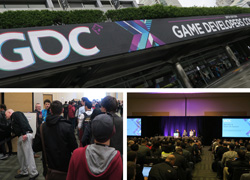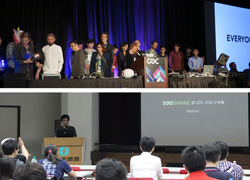Participation in GDC (Game Developers Conference) 2016Date: 2016-06-07
Section: Exchanges |  因過去國內鮮有遊戲開發與相關技術分享交流場合,獨立遊戲開發團隊普遍也難有機會自主參與國外遊戲開發論壇,故本會自 2011 年起派員參訪GDC,並將研習心得與相關資訊和國內獨立遊戲開發者交流。GDC 2016 於 3月14日至18日在美國舊金山舉行,包含遊戲開發經驗的分享、新趨勢及技術的詳解,而今年與首屆虛擬實境研發會議合併舉辦,許多開發者都在探索如何才能設計出優質的VR內容。 因過去國內鮮有遊戲開發與相關技術分享交流場合,獨立遊戲開發團隊普遍也難有機會自主參與國外遊戲開發論壇,故本會自 2011 年起派員參訪GDC,並將研習心得與相關資訊和國內獨立遊戲開發者交流。GDC 2016 於 3月14日至18日在美國舊金山舉行,包含遊戲開發經驗的分享、新趨勢及技術的詳解,而今年與首屆虛擬實境研發會議合併舉辦,許多開發者都在探索如何才能設計出優質的VR內容。
In the past, there had rarely been any occasion for game developers to exchange information regarding game development and technology in Taiwan. Indie game development teams often don't have the chance to participate in game development forums overseas. Thus, since 2011, the ARF has been sending representatives to the annual GDC, and they have been sharing their feedback and exchanging related information with indie game developers in Taiwan. GDC 2016 was held in San Francisco from March 14 to 18. The conference focused on sharing experience in game development, and explanation of new trends and technologies. This year, the first Virtual Reality Developers Conference was held alongside GDC, allowing developers to explore ways to design better VR contents.
 向來為GDC最重要的大型發表活動Experimental Gameplay Workshop,安排在GDC 2016第五天舉辦,所徵選的遊戲稿件主打實驗性質,讓天馬行空的新奇發想可激盪出更多火花。為將此行相關的見聞分享,本會亦贊助國際遊戲開發者協會台灣分會協同資策會於2016 於 5月7日,舉辦 GDC 2016 參訪後分享會,希望可以藉著經驗交流,讓國內其他開發者更了解國際會展狀況。 向來為GDC最重要的大型發表活動Experimental Gameplay Workshop,安排在GDC 2016第五天舉辦,所徵選的遊戲稿件主打實驗性質,讓天馬行空的新奇發想可激盪出更多火花。為將此行相關的見聞分享,本會亦贊助國際遊戲開發者協會台灣分會協同資策會於2016 於 5月7日,舉辦 GDC 2016 參訪後分享會,希望可以藉著經驗交流,讓國內其他開發者更了解國際會展狀況。
The Experimental Gameplay Workshop held on the 5th day of GDC 2016 had traditionally been the most important GDC event for developers to submit their games. The workshop invites submissions that are experimental and aims to ignite creativity through unbridled imagination. To share information on GDC 2016, the ARF sponsored the Taiwan chapter of the International Game Developers Association to hold a meeting in association with Institute for Information Industry on May 7, 2016, to allow those who attended GDC 2016 to share their experience with other developers in Taiwan to understand more about the international event.
|
|